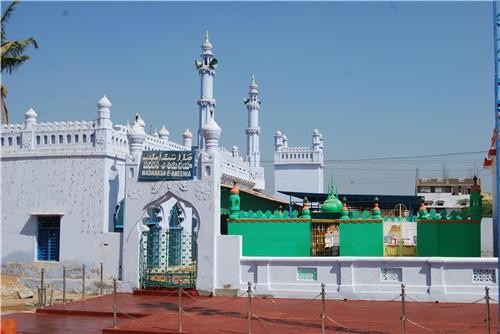This is the Sixth in the series on South Indian Mosques/ Dargah’s. This series will highlight the oldest, most popular worshipping places of Islam in this part of the country.
What is common between Indra Gandhi, N Chandrababu Naidu, AR Rahman and Aishwarya Rai? They all have prayed at the famous Dargah in Kadapa district in Andhra Pradesh state. Irrespective of their religious affiliation many, like these celebrities, have paid and continue to pay their visits to this Dargah for they believe that it is a miracle place where one’s wish gets fulfilled.
What is this Dargah and why is it so famous? It is the Ameen Peer Dargah. It is a perfect example of communal harmony, where people of all faiths congregate and pray. This is not a new phenomenon, but it has been time immemorial a representation of communal harmony in this country. It is popularly known as Badi Dargah.
Legend of Ameen Peer Dargah
Legend has it that once some people demanded that they would trust Khwaja Peerullah Malik only if he could show them a miracle. The Sufi saint went ahead and accepted their challenge. The earth opened for Peerullah Malik and he descended into it alive, thereby attaining a burial while alive here on the 10th day of Muharram month (in the year 1716 AD). Three days later, people saw him performing prayers in the same place. After his death, Nawab Abdul Hameed Khan Mayana got his mausoleum built. Just to the east of the mosque, Peerullah’s tomb is found in a closed room with two entrances, one each in the western and southern walls. Peerullah’s Urs is celebrated on the 10th day of Muharram every year.
Khwaja Peerullah had two sons. One of them died childless. The other sonArifullah Hussani-I attained higher levels of mysticism and spirituality. His son Ameenullah Hussaini-I, had three sons: Shah Peerullah Hussaini, Yadullah Hussaini-I, and Arifullah Hussaini-II.

Arifullah Hussaini II was a devout Sufi and he immersed himself in the love of God. Legend has it that he once paid a visit to his grandfather’s tomb atBidar. The gateman asked for his credentials and refused to open the door for him. The saint called (Ya Jaddi, O’ father) loudly. Then a voice from the tomb (Marhaba Ya Waladi, Come, my son) welcomed him. The door automatically opened for him. Arifullah II spent some time there, and then shifted to the mausoleum of Ameenuddin Aala at Bijapur. He went to Ahmedabad and Ajmer, where he received instructions for going to Tadipatri (Anantapur District). He spent 40 years in deep meditation and prayers in the caves and forests of Tadipatri. It is also believed that a python used to stay guard outside his cave. He came to the forests of Cuddapah district and spent his time in prayers till he turned 63. Besides being a saint of high order, he was also a great scholar, and an eminent poet.
South india Mosques : Kilakarai – Temple – Mosque stands for Testimony of Time
There is a wide hall along the east-west axis consisting of a number of tombs. The highest tomb among them belongs to him, whose Urs is celebrated in Jamadi’ul Awwal (5th lunar month) of Muslim calendar. It is the biggest Urs of South India. The entire mausoleum complex is popularly known as Aasthana-e-Maqdoom’ullahi. This Urs brings millions of pilgrims to Kadapa from every nook and corner of the country, from as far as Delhi, Agra, Ajmer, Chennai, Bangalore, Calcutta, Jammu, Ahmedabad, Mumbai and Bhopal, and from beyond the country as well.

History
The masjid is believed to be constructed in 1683. Thenplace is originally a grave place for the two Sufi saint – Perullah Hussaini and Arufulla Hussaini II. The then Nawab of Sidhout Taluk, Nawab Nek nam Khan changed the name of this place t Neknamabaad. It eventually became Kadapa. So, there is a great significance of this Ameen Peer Dargah in the chronological events of Kadapa. It is also called by locals as Taj of Kadapa.
The Biggest Urs
This Urs brings millions of pilgrims to Kadapa from every nook and corner of the country, from as far as Delhi, Agra, Ajmer, Chennai, Bangalore, Calcutta, Jammu, Ahmedabad, Mumbai and Bhopal, and so on. The main festivities start with the sandal paste ceremony. It is taken out in the night and Fateha is offered at the tomb of the saint. The sandal paste is treated as Tabarruk (prasada) and is distributed to the devotees. The main Urs ceremony is held on the second day. Fakirs and devotees present Chadar at the tomb of the saint. Qawwali programme is held on both nights. A national-level Mushaira (poetry programme) is held on the third night which continues up to early morning. Masjid-e-Azam is an impressive mosque with Persian inscriptions. It dates back to A.D. 1691 and was built during the reign of Aurangazeb.
Must Read South India Mosques : Valiyangadi Juma Masjid: Muslim Hindu unity Story
Must Read South India Mosques : Cherman Perumal Jumma Masjid – India’s Oldest Mosque









